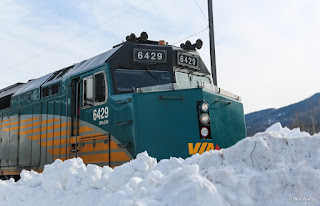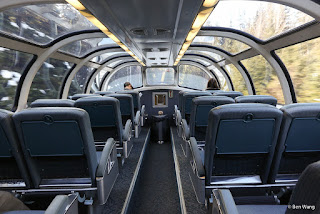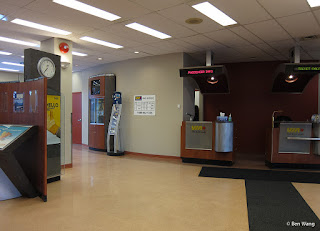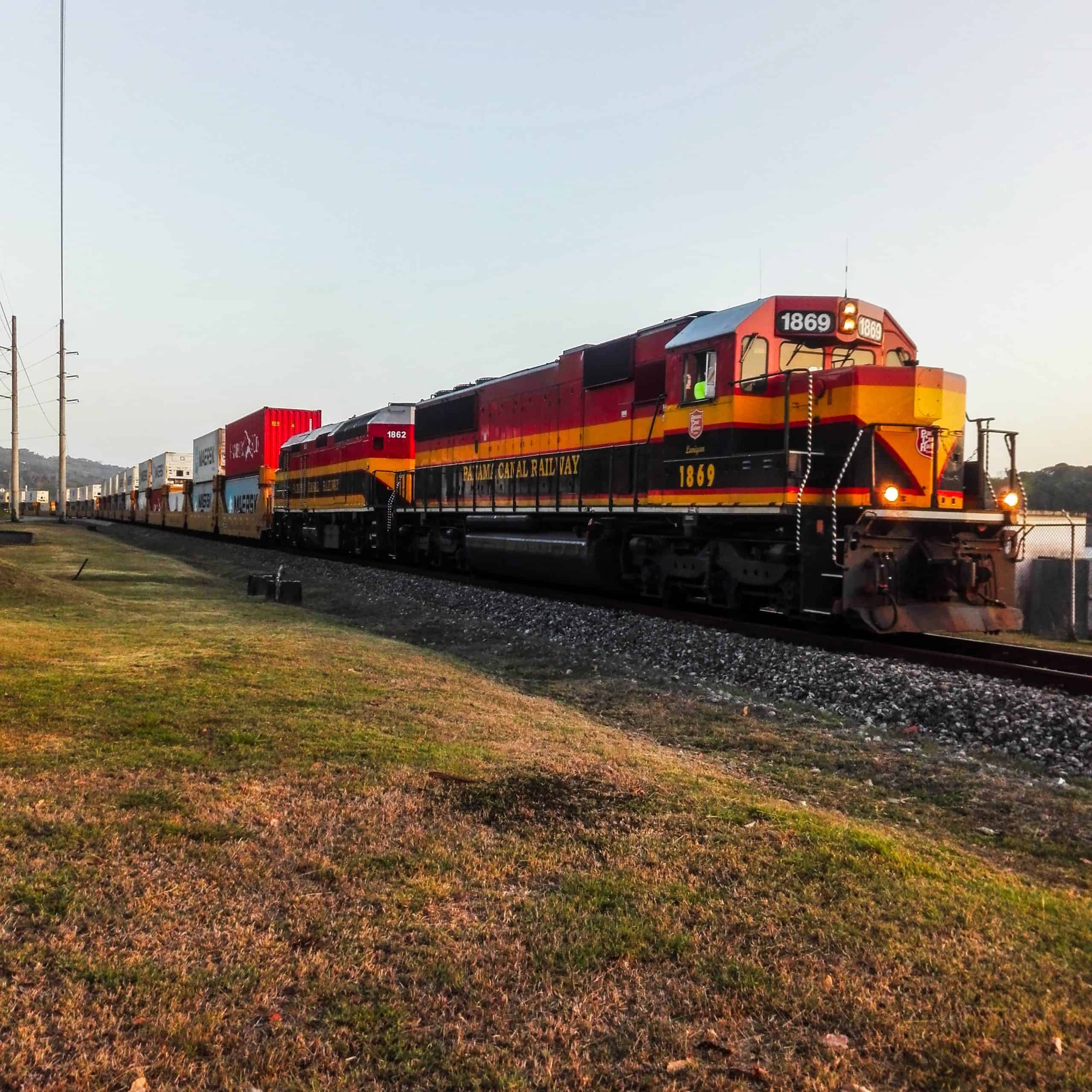
VIA Rail’s Jasper –
Prince Rupert Train used to be a named train – The Skeena – after the river it runs alongside with for about 170 miles
on its journey. Now simply known by a
boring name, it is nevertheless a specular ride: through the Rockies, along
three different rivers, across dense forests, lumber mills, towns small and
large, right down to individual outposts.
The westward journey ends at the Pacific Ocean at Prince Rupert, an
important port in northwestern British Columbia. More than a scenic ride, the Jasper – Prince Rupert Train is also a
flag stop train that provides a crucial lifeline to those that live in the
remote areas along the way.
The 1160 km (721 mile) trip takes two days, making an
overnight stop at Prince George, British Columbia, making it a day-time only
train. The train offers simple coach
seating (“Economy Class”) and snack/bar service in the winter. In the summer, on certain days, the train
picks up a Panoramic Car as part of “Touring Class” (reserved seats in a big
window car and meals included).
Throughout the year, the majestic boat tailed dome car known as the Park Car rounds the train.
 |
| The Park Car |
 |
| Coach – or Economy Class |
I rode westbound train #5 that departed from Jasper,
Alberta. I arrived at the picturesque
Rocky Mountain resort town on train #1, the westbound Canadian, from Toronto.
Since neither the Canadian nor
the Jasper – Prince Rupert Train run
daily, the best connection is a 23-hour overnight layover. As it turned out, I needed most of that time.
With Canadian’s
now-expected-as-normal lengthy delays, I arrived at Jasper 18-hours late, early
in the morning the next day. Good
news: I got to enjoy Canadian’s famous Rack of Lamb on the
dinner service that I would have missed; bad news: I stayed just four-hours at the hotel that I
had already paid for in Jasper.
Day 1
Departure from Jasper on this Wednesday afternoon was
delayed by 20 minutes. The train took a
while being made up only one hour before departure: cutting cars, locomotives,
wying in the Jasper yard. The short
three-car train consisted of a F-40 locomotive (#6429), baggage car (#8613),
coach (#8133), and dome car (#8714, Strathcona
Park).
On board, Train Manager J-F briefed safety instructions and
service available. As it turned out, J-F
was the only customer-facing staff member on board. J-F played the role of Train Manager/Baggage
Man/Service Attendant/Bartender/Tour Guide for the whopping six
passengers. Five of us came off the Canadian earlier that morning, to which
J-F was sympathetic of our plight.
Besides me, there was only one other tourist on board: a fellow from the
U.K. who joined the Canadian at
Edmonton. It was supposed to be a
seven-hour morning scenic ride to Jasper that turned out to be an overnight
trip in his coach seat.
Unlike the Canadian,
the Park Car on the Jasper – Prince Rupert Train had not
been refurbished and still sported the green-gray VIA interior from the
1990s. Worn and drab looking, this Park was showing its age. Nevertheless, the windows were crystal clear
and clean (much better than one of the Skyline
domes on my Canadian train), and the
interior was kept spick and span.
Despite having four bedrooms and one drawing room in this car, they are
not sold on this train. Only the drawing
room is occupied: by the Train Manager himself!
Indeed, according to J-F, the Jasper
– Prince Rupert Train is the most senior route at the Vancouver base. There are no dishes to wash, no beds to make,
and the trips are short and easy.
Despite the easy trip and small crowd, J-F’s service was top notch. It was comparable or better than those found
on board the Canadian, VIA Rail’s
premier train. J-F provided scenic
commentary for all three passengers that chose to spend their time in the dome
and even asked the engineers to slow down at scenic points of interest. In between sights, J-F cheerfully fulfilled
drink and snack orders at the bar. It
literally felt like a private train with the conductor AND bar attendant at
your disposal!
Upon departure from Jasper, our train made a smoky assault
through the Rockies – peaking at the Continental Divide at Yellowhead Pass
(elevation 1133 m / 3717 ft). There, we
crossed the border between Alberta and British Columbia and set our watches
back one hour to Pacific Time Zone.
After running past a mostly obscured Mt Robson (highest peak
in the Canadian Rockies), at Moose Lake, we met the Fraser River which we
followed all the way to Prince George.
 |
| Mt Robson – somewhere behind the fog |
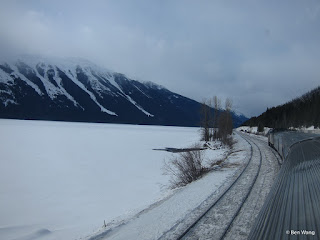 |
| Moose Lake |
 |
| Fraser River |
The
knockout punch of the Rockies quickly settled to gentle mountains as we
paralleled the Cariboo Mountains while we meanderer through valleys carved by
the Fraser.
We slowly approached McBride, passing the elegant Grand
Trunk Pacific station built in 1919.
Flag stop signal absent, we rolled on.
I later learned the flag for this particular stop is the station garbage
can positioned at a specific spot. Along
the route, each flag stop passenger creates their own unique signal (or “flag”)
for the train. The only requirement is the
flag has to be on a pre-determined straight track distance where the engineers would
have enough time to see the flag and stop the train. All of the flaggers are regulars on the
train, so engineers are familiar with every seemingly-out-of-nowhere stop in
the wilderness. On board, if the passenger
was riding the train to their flag stop, they know precisely the milepost for
their stop – right down to two digits past the decimal point. Impressive!
We made good running times on this first leg of the journey,
passing three CN trains – two double-stacks and a mixed freight – and one CP
loaded coal train.
When dinner time
arrived, I had a choice between two different kinds of refrigerated sandwiches
from the snack bar. Hot selections in
the menu (I wanted pizza) were not available.
My roast beef and cheese was petrified, but served its purpose as
sustenance. No new catering would be boarded
at Prince George, so J-F gave me some suggestions of where to pick up food in
town for the next day’s journey.
We were on track for 7:30 pm arrival to Prince George, a reasonable
22 minutes delay. For those of us
staying overnight, J-F ensured we knew where we were going and paired up those that happened to book the same hotel (share a
taxi or walk together).
As soon as we repacked our bags and put our coats on (with
map in hand), we came to a halt just outside of town. Bad news.
The yardmaster wanted to hold our train so two eastbound freight trains
can depart the yard. One hour quickly
turned into 90 minutes. J-F graciously
brought us hot chocolate while we waited.
When we finally rolled into Prince George, our nonstop train with only
six passengers on board arrived over two hours late at 9:20 pm.
Day 2
After a night at the Travelodge with a conveniently located
Tim Horton’s on the next block (I would be having Timmy’s for breakfast, lunch,
and dinner this day), I walked six big city blocks back to the station.
Prince George station is modern but architecturally boring. VIA Rail shares the building with the local
tourism board and other office tenants.
The journey on day two began with 12-passengers; three of us
continued from the previous day. Train
Manager J-F came into the station, walked to the boarding door and gave a big
wave: “westbound train, everyone let’s go”.
And off we went! Once again, it
was a very family-like, community atmosphere.
At 7:56 am, train number 5 pulled out of Prince George, four minutes
early. We paused next to our eastbound
twin parked short of the station for the engineer to retrieve something from
the locomotive.
Hot tea with the morning paper. With just one other passenger in the dome – this is the life!
At Prince George, the Fraser River continues its flow south
to the Pacific Ocean at Vancouver. Our
train now joined the Nechako River.
The morning took us through the forestry industry with numerous lumber yards (majority on the left side heading westbound)…
…and towns that grew around them (like Vanderhoof).
Appropriately, we passed
two eastbound trains carrying woodchips – supposedly a new source for
fuel.
We also made our only flag stop of
the trip – a drop off. The hearty
wilderness fellow assured us minimum disruption by disembarking directly from
the baggage car and unloading his own cargo.
Our train drift past Fraser and Burns Lakes, popular spots
for boating and water recreation.
However, now in winter, iced and snowed over, there was no distinction between
land and water. Remnants like a pier and
beach playground provided clues that these desolate scenes offer wet fun in the
warmer months.
Alas, it started snowing.
Despite sleet quickly dotting the windows, it was mesmerizing watching
icy rain drops and snow flurries crashing against the dome.
More lakes, more sawmills.
This ain’t no Texas!
Overtaking a westbound CP coal train.
Approaching Smithers, we overtook this parked train with a
sad looking BC Rail Dash 8-40CM on the second unit.
We pulled into Smithers for a fresh air stop and an
operating crew change. Despite running
45 minutes late, J-F still gave everyone ample time for get some cold outside
air and a smoke break. A good number of
passengers also departed train here. Arriving
in the middle of the afternoon, Trackside
Cantina inside the 1919-vintage depot had just closed after lunch. The smell inside the depot made me crave for
chips and salsa.
Smithers is surrounded by four mountain ranges. Wispy clouds hung along mountain peaks as the
sky continued to clear.
After passing
community of New Hazelton, we joined the Skeena River, the (former) namesake
for our train.
Crossing the Skeena on a historic 1912 bridge.
With the setting sun, we ran alongside the Skeena and the
Hazelton Mountains, passing a row of distinctive sawtooth peaks known as the
Seven Sisters.
Our daylight run alongside the Skeena River would be
shortlived. We held for more than one
hour at Pacific siding, about 30
miles outside of Terrace for an eastbound train. There, the sun sat bringing sightseeing to an
end.
We pulled into Terrance two hours late. Here, we picked up five or six passengers and
paused for another fresh air / smoke break stop. The depot, built in 1914, is actually the
former home of the town founder, George Little.
Upon departing Terrance, J-F briefed passengers that he
estimates arriving in Prince Rupert at 10 pm (two hours late), but was
confident that it would be sometime today.
At Port Edward, seven rail miles from our final destination,
we made a (seemingly inexplicable) stop at a grade crossing. “Ladies and gentlemen, our trip ends here
tonight,” announced our Train Manager. I
was puzzled yet amused at the same time.
There was a freight train blocking the entrance to the Port and its crew
was not expected until midnight. Sadly, this
was a comical yet common theme throughout my Canadian rail journey.
J-F called in taxis from Prince Rupert that would take us to
our final destination in town. Well, at
least I didn’t have to get myself to my hotel: VIA Rail picked up the entire
tab.
 |
| Final stop for the passengers on this night! The train needed to continue to the station proper for the trip east the next morning. |
 |
| Seven miles from my intended destination, my rail journey across Canada ended unceremoniously at a grade crossing, completing the trip in a taxi. |
If I was taking this train again, I would take it eastbound departing
from Prince Rupert. Departing at 8 am,
the beautiful scenery alongside the Skeena between Prince Rupert and Terrance
would be guaranteed in daylight. Sure, in
the winter, the run through the Rockies and the arrival in Jasper would most
likely be in darkness. However, since
part of the route is on the same trackage as the Canadian, anything missed I would have seen previously.
My experience onboard the Jasper – Prince Rupert Train was absolutely fantastic! Train Manager J-F really made it special,
exceeding all of my expectations. Where
else could one have a private train experience at an economy class price?
Prince Rupert’s original CN station (built in 1921-22) is located
at the waterfront at town center. This
sad-looking boarded up brick building is a designated Canadian Historical
Place. In the background is Kwinitsa Depot,
a Grand Trunk Pacific “Type E” station built in 1911. It was moved here in 1985. Supposedly a museum, it appeared to be
abandoned. VIA Rail’s current Prince
Rupert station is two miles away, at the edge of town, co-located with the
ferry terminal.
